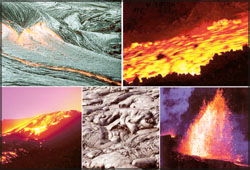|
observer |
|
|
|
|
|
OTHER LINKS |

|

|

|
|
Lava: When 'middle earth' flows outWhat do you know about lava? You are sure to know about the relationship between lava and volcanoes. Today, from Geo Facts, we provide you with information on lava. Lava is a molten (liquified by heat) or partially molten rock that erupts (bursts) at the earth's surface. When lava comes out to the surface, it is red-hot, reaching temperatures as high as 1200 degrees Celsius (2200 degrees Fahrenheit).
Some lava can be as thick and viscous (gluey) as toothpaste, while other lava can be as thin and fluid as warm syrup and flow rapidly down the sides of a volcano. Molten rock that has not yet erupted is called magma. Once lava hardens, it forms igneous rock (rocks formed by volcanic acts). Volcanoes build up where lava erupts from a central vent (opening). Flood basalt forms where lava erupts from huge fissures (splits). The eruption of lava is the principal mechanism whereby new crust is produced. Since lava is generated at a great depth, its chemical and physical characteristics provide indirect information about the chemical composition and physical properties of the rocks located 50 to 150 km (30 to 90 miles) below the surface. Most lava, on cooling, forms silicate rocks - rocks that contain silicon and oxygen. Lava is classified according to which silicate rocks it forms: basalt, rhyolite or andesite. Basaltic lava is dark in colour; it's rich in magnesium and iron, but poor in silicon. Rhyolitic lava is light coloured and poor in magnesium and iron, but rich in silicon. Andesitic lava is intermediate in composition between basaltic and rhyolitic lava. While the colour is often sufficient to classify lava informally, formal identification requires chemical analysis in a laboratory. If silica (silicon dioxide) makes up more than 65 per cent of the weight of the lava, then the lava is rhyolitic. If the silica content is between 65 and 50 per cent by weight, then the lava is andesitic. If the silica content is less than 50 per cent by weight, then the lava is basaltic. Many other physical properties, in addition to colour, follow the distinctions between basaltic, andesitic, and rhyolitic lava. For example, basaltic lava has a low viscosity, meaning it is thin and runny. Basaltic lava flows easily and spreads out. Rhyolitic lava has a high viscosity and oozes slowly like toothpaste. The viscosity of andesitic lava is intermediate between basaltic and rhyolitic lava. Similarly, basaltic lava tends to erupt at higher temperatures, typically around 1000 to 1200 degrees Celsius (1800 to 2200 degrees Fahrenheit), while rhyolitic lava tends to erupt at temperatures of 800 to 1000 degrees Celsius (1500 to 1800 degrees Fahrenheit). Dissolved gases make up between one and nine per cent of magma. These gases come out of the solution and form gas bubbles as the magma nears the surface. Rhyolitic lava tends to contain the most gas and basaltic lava tends to contain the least. Lava can erupt in several different ways depending on the viscosity of the lava and the pressure from the overlaying rock. When lava erupts out of a vent or large crack, it may pour like water coming out of a large pipe. The lava flows downhill like a river and can also form large lava lakes. The rivers and lakes of lava are called lava flows. At other times, the pressure exerted by gas bubbles in the lava is so high that it shatters the overlying rock and shoots lava and rock fragments high into the air with explosive force. The fragments of hot rock and lava which shoot into the air are called pyroclasts (from the Greek words pyro, which means fire, and klastos, which means fragment). At other times, the pressure may be so great that the volcano itself is destroyed in a massive and violent explosion. There are two basic eruption styles of lava. They are Pyroclastic Eruptions and Explosive Eruptions, which can even generate giant tsunami waves. We'll talk about these eruption styles in a future article. |












